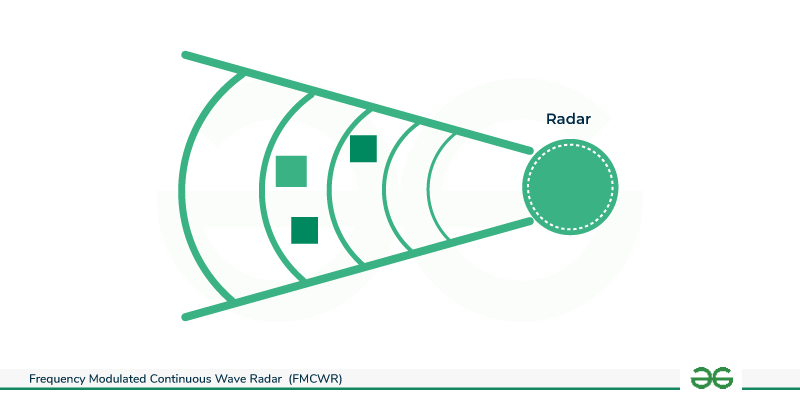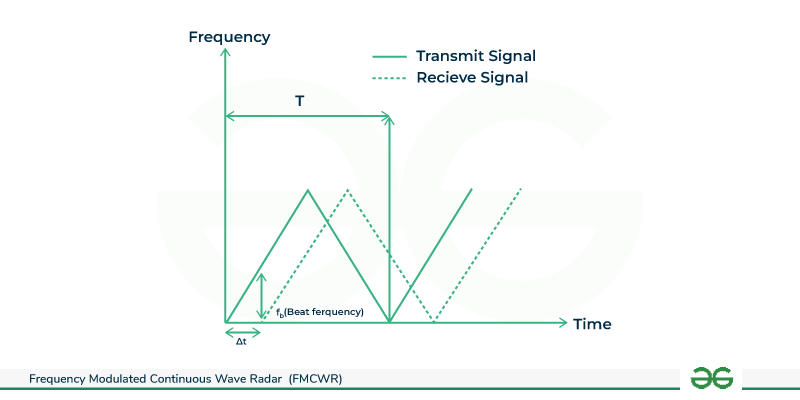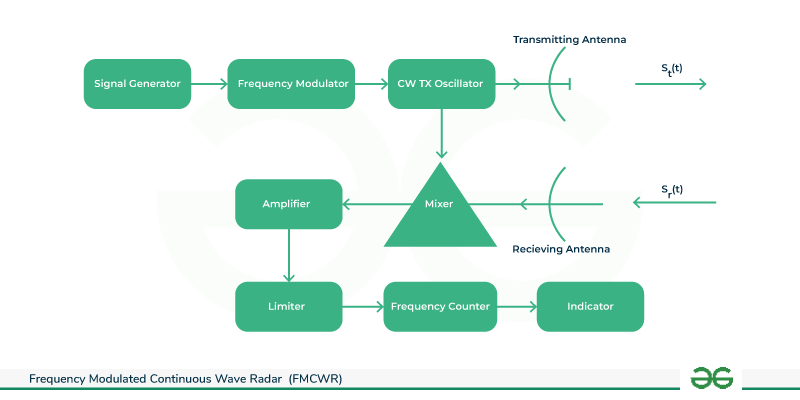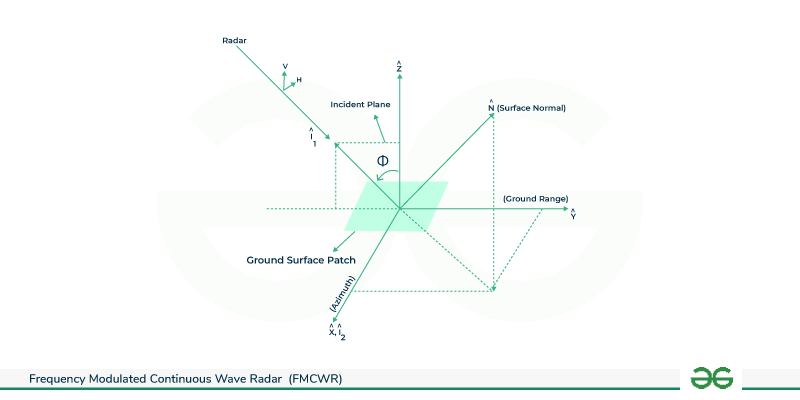In this article, we will be going through FMCW Radar, First we will start our Article with the definition of the FMCW Radar, Then we will go through the Principle Operation of FMCWR with its characteristics, Then we will go through the definition of the Maximum Range and Range Resolution and go through Block diagram of the FMCW Radar. At Last, we will conclude our Article with its Advantages, Disadvantages, Application, and Some FAQs.

Frequency Modulated Continuous Wave Radar
What is Continuous Wave Radar?
FMCW Radar is a high-tech radar way that always sends out signals with changing frequency over time. Unlike old radar systems that quickly send out strong pulses, FMCW Radar uses a constant wave pattern. This makes it extra useful, and very significant when measuring distance and speed.
Frequency Modulated Continuous Wave Radar (FMCWR) represents a groundbreaking advancement in radar technology, revolutionizing the way we perceive, detect, and track targets in various fields of application. Departing from the conventional pulsed radar systems, FMCWR operates on the principle of continuous wave transmission with a dynamically changing frequency over time. This dynamic modulation provides FMCWR with distinctive advantages, making it a preferred choice across diverse sectors.
By using FMCWR, it helps us reach our goals faster. This is good when there’s too much noise or distractions around. Many people use it because they can change and be useful. This means making car crash safety better, getting important data for weather watching, and using it in protective roles. As we learn more about FMCWR, it’s clear that its unique features and abilities are changing how radar operates. This will provide a great future for many applications.
Principle of Operation of FMCWR
- Continuous Transmission: FMCW Radar always sends out a signal that changes its frequency slowly over time. People often get this frequency change using a saw-like or triangle shaped pattern.
- Transmission and Reflection: The sent signal goes through space until it meets a target. When the signal hits its goal, it bounces back towards the radar system.
- Frequency Shift: The signal sent back from the target changes its frequency depending on how far it is and how fast it moves. If the target is moving, changes in sound (beat frequency) between sent and received signals give information about how fast it’s going.
- Range Measurement: The time it takes for a signal to be sent and received helps us know how far away the target is. The longer you wait, the more distance is between the radar and target.

Principle-of-Frequency-Modulated-Continuous-Wave-Radar
Characteristics of FMCW Radar
Frequency-Modulated Continuous-Wave (FMCW) Radar has several distinctive characteristics that contribute to its versatility and effectiveness across various applications:
- Waveform With Continuity: FMCW Radar works with a nonstop and evolving waveform. This provides it with a steady progression of data. This relentless wave nature allows us to watch progressively and makes it simple to gauge distance from the objective as well as how quick it’s moving on the double.
- Direct Recurrence Regulation: The conveyed message goes through a straight recurrence change, as a rule, looking like a saw tooth or triangle line. This adjustment of the example makes it more straightforward to handle signals and gets significant subtleties, similar to removing the objective and its speed. This way, FMCW radar is perfect for extremely precise estimations.
- Measurement of both range and velocity simultaneously: A major benefit of FMCW radar is that it can gauge the distance and speed of focus simultaneously. This capacity to quantify things simultaneously is vital in assignments like vehicle radar for controlled driving and forestalling mishaps.
- High Reach Goal: The nonstop waveform and straight recurrence regulation add to a high reach goal, permitting FMCW radar to recognize firmly divided targets. This trademark is profitable in situations where accuracy in distance estimation is basic.
- Low Likelihood of Block (LPI): FMCW radar displays a low likelihood of catch because of its constant and low-power activity. This component improves its appropriateness for applications requiring secret or secure tasks, like military observation.
Maximum Range and Range Resolution
The following terms are discussed below in detail:
Maximum Range
Maximum Range means the longest distance radar can find a target and measure how far away it is. Figuring out how far the signal can go depends on things like, strength of sent message, ability to hear it at other side and what pattern is used.
Factors affecting Maximum Range:
- Transmitted Signal Power: Using more power lets the radar signal to go farther and still come back with a sign we can find.
- Antenna Gain: An antenna with more gain sends energy very strongly and makes the received signal better, increasing how far it can go.
- Sensitivity of Receiver: A better listener can find weaker bouncing signals, letting us see targets from further away.
Range Resolution
Radar resolution is how well a radar system can tell apart nearby targets in the side-to-side direction. It’s affected by how wide the signal we send is and it’s very important for jobs that need to separate close things.
Factors affecting Range Resolution:
- Sweep Bandwidth: Having a bigger range lets us tell the difference between targets that are close to each other better. The more bandwidth, the better your range resolution gets.
- Signal Processing Techniques: Better signal processing tools can make things clearer by getting more details from the signals we get.
Modulation Pattern
The changing pattern in Frequency-Modulated Continuous-Wave (FMCW) Radar is the regular shift of a sent signal’s frequency over time. This changing is important to get useful details about the target, like its distance and speed. A often-used type of pattern is the sawtooth or triangle shape.
- Linear Frequency Change: The pattern of change in the transmitted signal is ongoing and follows a straight-line path. Usually, this shift happens in a shape that looks like the teeth of saw or triangle.
- Sweep Bandwidth: The variety of frequencies used in one full modulation round is called the sweep bandwidth. The more bandwidth a radar system has, the better it can tell where things are.
- Repetition Rate: It’s important to know how quickly the pattern is repeated in modulation for finding out how fast a radar system can be updated. More often updates can be made by doing this more frequently.

Modulation-Pattern
In this graph, the x-hub addresses time, and the y-hub addresses the recurrence of the communicated signal. The sawtooth design portrays the constant increment and ensuing reset of the recurrence. This example is central to FMCW Radar’s capacity to precisely quantify the reach and speed of targets.
Sawtooth Modulation
In Frequency-Modulated Continuous Wave (FMCW) Radar, the changing pattern of a sawtooth frequency is basic. This method lets us work easily with signals and accurately measure things like distance to targets or how fast they’re moving. This change in pattern goes up regularly and linearly with the sent signal, then suddenly resets to start again making a wave shape like teeth of saw. FMCW Radar systems often use a sawtooth pattern for frequencies changing. This is important in tasks like measuring range and speed in cars, where accuracy matters. This simple pattern of modulation in FMCW radar tech helps make it work better and more trustworthy.
- Continuous Increase: The sent signal gets stronger slowly with time, giving a reliable pattern of change.
- Reset (Sawtooth Pattern): When it hits a particular level, the change quickly goes back to where it started and forms an up-and-down wave shape. This reset is very important for making the signal processing and analysis easier.

Sawtooth-Linear-Frequency-Changing
Where:
fD: is the Doppler frequency shift, which is the difference between the frequency of the transmitted signal and the frequency of the received signal. It is caused by the relative motion between the radar and the target.
Delta f: is the frequency difference between the reflected wave and a local oscillator wave. this is used to determine the distance to the target.
Delta t: is the time delay between the transmission of the signal and the reception of the echo. this is used to determine the distance to the target.
In the outline, the x-pivot addresses time, and the y-hub addresses the moment recurrence of the communicated signal. The sawtooth design delineates the ceaseless expansion in recurrence followed by an unexpected reset, rehashing over the long run.
Block Diagram of an FMCW Radar Sensor
The Block Chart of a Recurrence Tweaked Consistent Wave (FMCW) Radar Sensor represents the vital parts and their communications in the radar framework. This outline gives an outline of the sign handling stages associated with removing important data from the communicated and got signals.

Block-Diagram-of-an-FMCW-Radar-Sensor
- Transmitter: The transmitter produces a radio recurrence (RF) signal that is balanced in recurrence. The recurrence balance can be direct, sawtooth, or three-sided.
- Receiver: The recipient gets the reflected RF signal from the objective and blends it in with the communicated sign to create a beat signal. The recurrence of the beat signal is relative to the Doppler shift of the reflected sign, which thus corresponds to the speed of the objective.
- Mixer: The blender blends the communicated and received signs to create a beat signal. The recurrence of the beat signal is relative to the Doppler shift of the reflected sign, which thus corresponds to the speed of the objective.
- Neighborhood oscillator: The neighborhood oscillator produces a reference signal that is utilized to blend the communicated and got signals.
- IF amplifier: The assuming speaker intensifies the beat signal.
- Detector: The identifier changes over the beat signal into a voltage that is relative to the sufficiency of the beat signal.
- Discriminator: The discriminator changes the voltage from the indicator into a recurrence that is relative to the Doppler shift of the reflected sign.
- Filter: The channel eliminates any undesirable clamor from the result of the discriminator.
- Display: The showcase shows the speed of the objective.
Imaging FMCW Radar
Imaging Frequency-Modulated Continuous-Wave (FMCW) Radar is a high-level radar innovation that rises above conventional radar abilities by consolidating imaging highlights. Not at all like traditional radar frameworks essentially centered around target location and reach estimation, imaging FMCW radar adds a spatial aspect, empowering the making of nitty-gritty pictures of the noticed scene. This innovation has found applications in different spaces where envisioning the climate or targets is urgent, like independent routes, observation, and natural checking.
Working Principle of Imaging FMCW Radar
- Multiple Antenna Arrays: Imaging FMCW radar frameworks frequently include numerous receiving wire exhibits or collectors to catch signals from various points and work on spatial inclusion.
- Continuous Wave Transmission: Like standard FMCW radar, imaging FMCW radar persistently sends a waveform with a directly evolving recurrence.
- Complex Signal Processing: The signals go through complex sign handling, including Fourier changes and different calculations. This handling extricates both reach and Doppler data, pivotal for making itemized pictures.
- Range-Doppler Processing: By breaking down the reach and Doppler shifts in the signal, imaging FMCW radar recognizes objects at various distances and speeds. This considers the production of a reach Doppler map, shaping the reason for picture development.
- Synthetic Aperture Radar (SAR) Techniques: Some imaging FMCW radar frameworks utilize manufactured gaps in radar procedures. These include joining information from various radar sources to further develop the azimuth goal and upgrade picture quality.

Imaging-FMCW-Radar
Non- Imaging FMCW Radar
Non-imaging Frequency-Modulated Continuous-Wave (FMCW) Radar is a radar framework that fundamentally centers around the identification and following of focuses without creating itemized pictures of the general climate. Dissimilar to imaging radar, which produces spatial portrayals of the scene, non-imaging FMCW radar underscores removing fundamental boundaries, for example, target reach and speed, for different applications.
Working Principle of Non – Imaging FMCW Radar
- Continuous Wave Transmission: Like imaging FMCW radar, non-imaging FMCW radar ceaselessly communicates a waveform with a recurrence that changes straightly over the long run.
- Range and Velocity Measurement: The essential goal of non-imaging FMCW radar is to gauge the reach and speed of targets inside its location range. The recurrence shift or beat recurrence between the sent and received signals is dissected to decide these boundaries.
- Sawtooth Frequency Modulation: The straight recurrence balance is in many cases accomplished through a sawtooth waveform, improving signal handling and considering productive extraction of target data.
- Signal Processing: The signals go through signal handling to dissect the recurrence shift and time delay, giving exact estimations of target reach and speed.
- Applications: Non-imaging FMCW radar is used in applications where creating point-by-point pictures is certainly not a necessity. Normal applications incorporate car radar for crash aversion, altimeters for flying, and general reconnaissance frameworks.

Non–Imaging-FMCW-Radar
Advantages and Disadvantages of FMCWR
The advantages and disadvantages of frequency modulated continuous wave radar are as follows:
Advantages
- Concurrent Reach and Speed Estimation: FMCW radar engages the simultaneous assessment of target reach and speed, giving comprehensive information about recognized objects.
- High-Definition Resolution: The relentless waveform considers high exactness in range assessments, making FMCW radar sensible for applications requiring fine distance separation.
- Low Probability of Intercept (LPI): Because of its consistent wave activity at low power levels, FMCW radar is less vulnerable to enemy recognition and has a lower likelihood of being blocked.
- Persistent Wave Activity: FMCW radar operates in a never-ending fashion, providing a consistent flow of information for constant monitoring and location
- Versatility to Different Applications: FMCW radar is adaptable and finds applications in various fields like vehicle radar, altimeters, perception, and atmospheric condition checking.
Disadvantages
- Complex Sign Handling: Modern sign-handling calculations are used to operate FMCW radar, which can make the framework plan more complicated.
- Defenselessness to Mess: While FMCW radar has parts to decrease wreck, it may, regardless, be sensitive to reflections from contiguous articles, impacting its display in confused conditions.
- In some applications, the maximum range is limited: When compared to specific heartbeat radar systems, the most extreme scope of FMCW radar may be limited, particularly in applications where long-range recognition is essential.
- Cost and Size: Achieving tip-top execution FMCW radar with state-of-the-art features, such as imaging capacities, may extend the general cost and size of the radar structure.
- Reliance on Linearity: The straight repeat guideline in FMCW radar relies upon the linearity of parts, and deviations from linearity can introduce botches in reach and speed assessments.
Applications of FMCWR
- Car Radar Frameworks: Autonomous Cruise Control, or ACC: FMCW radar is utilized in ACC frameworks for keeping a shielded following part by continually evaluating the range of the vehicle ahead. Impact aversion: used in automobiles to detect and avoid collisions by continuously measuring speed and distance.
- Level Assessment in Flying: In air transportation, FMCW radar altimeters are used to check level and add to safe flight and landing strategy definitively.
- Observation and Monitoring: In military and security surveillance systems, FMCW radar is used to recognize, track, and screen centers in a large number circumstances.
- Weather conditions Checking: Environment radar systems use FMCW advancement for careful assessment of precipitation rates, storm improvement, and other meteorological limits.
- Modern Industrial Applications: Level Estimation: In today’s tanks and vessels, FMCW radar is utilized for non-contact level estimation. Deterrent Recognition in Advanced mechanics: applied in mechanical innovation for catch disclosure and revulsion in gathering and dissemination focus conditions.
- GPR (ground penetrating radar): FMCW radar is used in GPR systems for underground imaging, including applications like archeological designs and utility game plan.
- Respiratory Noticing: In clinical idea, FMCW radar has been researched for non-contact respiratory warning, giving a customary gadget to patient checking without authentic contact
- (SAR) Synthetic Aperture Radar: For imaging, SAR systems use FMCW innovation, considering high-goal photos of scenes and scenes.
Conclusion
All in all, recurrence-balanced ceaseless wave (FMCW) radar arises as an extraordinary innovation, reclassifying the scene of radar applications with its persistent wave regulation and high-level capacities. The flexibility of FMCW radar to a large number of ventures, from auto security to weather conditions observation and reconnaissance, highlights its adaptability and true effect. Its extraordinary capacity to at the same time, quantify reach and speed with high accuracy positions it as a critical device in powerful and demanding situations. The reconciliation of imaging highlights further extends its utility, giving itemized spatial data to applications like independent routes and natural checking. Despite its benefits, difficulties, for example, complex sign handling and vulnerability to mess should be tended to. FMCW radar’s importance lies in its constant development, assuming a critical part in forming the fate of radar innovation and adding to headways in well-being, security, and productivity across different spaces.
FAQs on FMCWR
What distinguishes FMCW radar from conventional pulse radar systems?
In contrast to conventional pulse radar, FMCW radar continuously transmits a waveform whose frequency changes linearly over time. This nonstop waveform empowers concurrent reach and speed estimations, giving unmistakable benefits in applications like car radar and reconnaissance. Conversely, beat radar frameworks transmit short explosions of high-power beats, making them more appropriate for specific long-range recognition situations.
What distinguishes FMCW radar from regular heartbeat radar frameworks?
As opposed to ordinary heartbeat radar, FMCW radar ceaselessly sends a waveform whose recurrence changes directly over the long haul. This constant waveform enables simultaneous reach and speed assessments, giving unquestionable advantages in applications like vehicle radar and observation. Alternately, beat radar structures communicate short blasts of high-power beats, making them more fitting for explicit long-range acknowledgment circumstances.
How does FMCW radar add to weather conditions for observing and forecasting?
FMCW radar assumes an essential part in weather conditions checking by giving itemized and exact data about precipitation designs. Climate radar frameworks, using FMCW innovation, can gauge precipitation rates, storm development, and other meteorological boundaries. Forecasting and early warning systems rely on this information to manage disasters and ensure public safety during severe weather.
Share your thoughts in the comments
Please Login to comment...